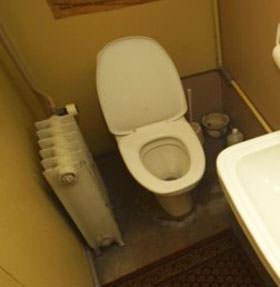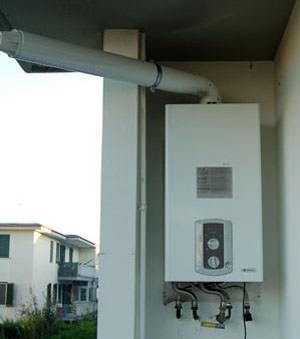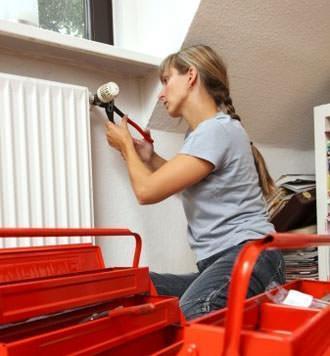Alternative radiators
Post from EditorialsHow to improve comfort in the home, through a simple upgrading of the existing heating, using the fan.
Radiators and their functioning
 The physical principle by which in a closed loop circuit, the heated water by decreasing in density causes, climbing up inside the circuit, the displacement to the bottom of the remaining part of the liquid at lower temperature, has inspired the creation of one of the most common elements existing in living spaces: the radiator.
The physical principle by which in a closed loop circuit, the heated water by decreasing in density causes, climbing up inside the circuit, the displacement to the bottom of the remaining part of the liquid at lower temperature, has inspired the creation of one of the most common elements existing in living spaces: the radiator.
Of this apparatus, composed of elements assembled together and realized in different size, materials, shapes and colors, what remains always unchanged, is the physical principle which enables the operation, with the aid of an adequate boiler proportionate to the thermal needs of the environment to be heated.
The principle described above, also called natural circulation, has been exploited in the first heating systems around the world, while in the modern installations, the water circulation is forced by the presence of heat pumps, which facilitate a faster liquid circulation, thus providing the possibility of feeding radiators placed even at a lower level than the boiler.
Project selection criteria
The choice of the boiler, the number and type of items to be placed inside a house, can not be entrusted to the usual empirical methods, with which, improvised or assumed installers, try to solve the problem. It must be that a qualified and competent technician, make a first examination of the condition of the premises, in order to calculate based on the volume of air to be heated, the current leakages and other important factors such as exposure of the premises, the number and position of the elements which provide the necessary comfort to the room.
It must be that a qualified and competent technician, make a first examination of the condition of the premises, in order to calculate based on the volume of air to be heated, the current leakages and other important factors such as exposure of the premises, the number and position of the elements which provide the necessary comfort to the room.
If the process described above is not followed, leaving the initiative to those who have the necessary expertise to solve the problem, the consequences of such a choice will be evident soon.
The most common events are represented by rooms which are or just too heated up or slightly warm, as a conseguent useles waste of energy and user inconvenience.
When one realizes the problem, the first solution is to change the whole boiler for one with a higher power, useless move if the implant is not properly dimensioned, or by increasing the number of radiating elements, in order to reach the required temperature .
The latter solution, when the power of the boiler allows it, is a possible solution to solve the problem of a non-heated enough room, but even if it apparently seems easy to carry on, you will often face with limitations imposed by the particular positioning of the radiator, and the geometric characteristics of existing elements.
Alternative Radiators
Let's make a practical example: let's suppose that we have a heater located in the traditional position under the window, so the niche that host it does not allow us to adopt neither a greater number of elements, nor bigger elements. The condition described above, forces us to seek for a solution in which in the described size, can be installed a heater that has a heating capacity higher than the existing one, without causing installation problems.
The condition described above, forces us to seek for a solution in which in the described size, can be installed a heater that has a heating capacity higher than the existing one, without causing installation problems.
The alternative to traditional radiator, becomes even more important, when the size of the room to be heated is bigger, whereby to achieve a better result with greater thermal power, less time without complicated assembly operations, it is necessary to install a fan coil unit.
The fan coil is nothing more than a radiator that uses the forced ventilation to transfer heat, compared to traditional radiator, can reach, with the same radiant surface, high thermic powers.
Several companies, such as Sabiana , Galletti , Accorroni , produce excellent equipment for every need. In particular, the model of H2O Accoroni Ghibli, has good thermal power, small size and easy installation, without requiring excessive costs.
The depth  of the device, of just 194 mm, facilitates the insertion into tight spaces without particular problems, also the height of 481 mm. allows the use of the piping of the existing system, without performing any harmful junction operation.
of the device, of just 194 mm, facilitates the insertion into tight spaces without particular problems, also the height of 481 mm. allows the use of the piping of the existing system, without performing any harmful junction operation.
In fact, when you will be at the decion time to replace the existing radiator, whose center distance between the feeding pipes is 800 mm as in most cases or of 600 mm as in the case of radiators placed under the windowsill, just simply pull down some of the masonry to extract the existing pipes.
Later, it will be necessary to perform a simple cut of the pipes, connect the fan, close the part of the track that is no longer useful and, with a simple touch-up paint, there will be no trace of the intervention.
 The manufacturer declares that the model H2O, can supply power up to 3190 W depending on the temperature of the inlet water, it is also possible to order the device in your favorite colors.
The manufacturer declares that the model H2O, can supply power up to 3190 W depending on the temperature of the inlet water, it is also possible to order the device in your favorite colors.
The advantages of the use of such devices are many: first of all they are easy to clean, they do not allow the blackening of the walls in correspondence with the upward motion of the hot air as it happens with the traditional radiators, they heat the room very quickly and are provided with a thermostat that switches on the ventilation only when it is needed.
It is also possible to heat the room on a different speed depending on the needs of the moment, taking into account that even when the fan is switched off, it performs an heating action by convection, which has the advantage of eliminating the minimum noise, due to the operation of the internal fan.
The possibility to provide them with a weekly timer, it is very helpful in order to improve the room daily heating plan, avoiding waste and ensuring the possibility to find, when back at home, the temperature that you desire.
79734 REGISTERED USERS










